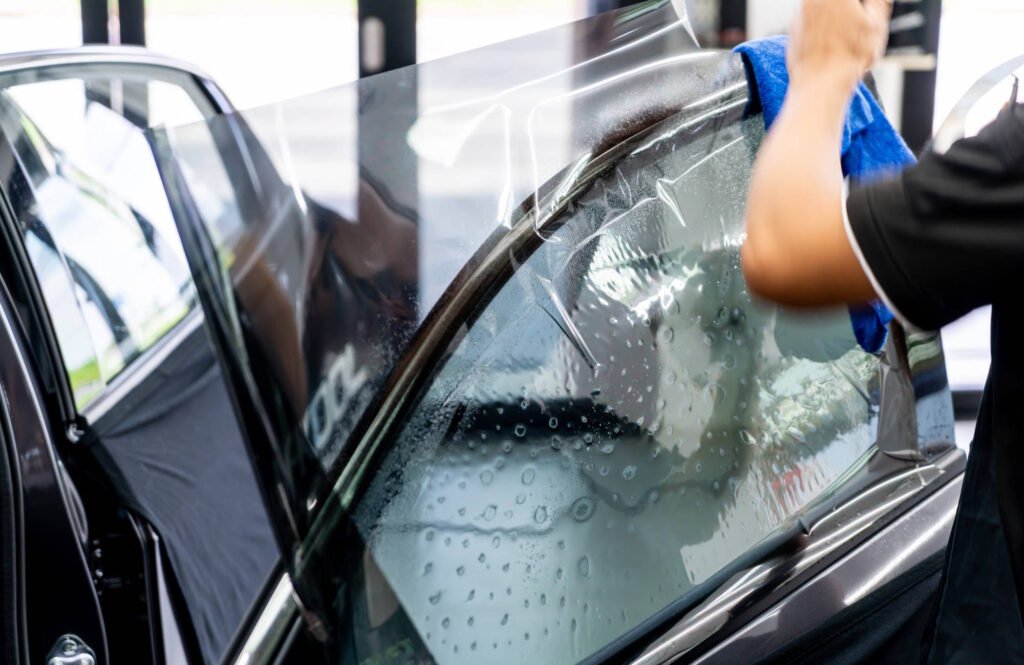Key Takeaways
- Window tinting offers effective UV protection, temperature regulation, enhanced privacy, and a stylish vehicle appearance.
- Choosing the right window film requires familiarity with regional laws, understanding of different tint materials, and alignment with personal preferences.
- Modern tint films offer advanced features, with ceramic technology setting a new standard for high-performance and durable protection.
- Expert installation and routine maintenance are essential in maximizing the lifespan and benefits of your auto window tint.
Why Tint Your Car Windows?
More than ever before, vehicle owners recognize the far-reaching benefits of auto window tint. Not only does it contribute to a sleek, contemporary aesthetic, but it also acts as a vital shield against the constant barrage of the sun’s rays. Extensive research by organizations like the Skin Cancer Foundation shows that high-quality window films can block up to 99% of harmful ultraviolet A (UVA) and ultraviolet B (UVB) rays.
These invisible dangers can contribute to skin cancer and the premature aging of skin, concerns that are especially pressing for those who spend considerable time on the road. By reducing UV exposure, window tinting helps safeguard your health every time you drive.
Comfort is another compelling reason for choosing window tint. The glare of the midday sun or an oncoming headlight can cause eye strain, making driving hazardous. Tinting significantly reduces glare, enhancing visibility and comfort. For those seeking tougher protection and longer-lasting results, options such as ceramic coating for cars in Newton, OH are engineered to deliver not only exceptional heat rejection but also resistance to scratches and environmental contaminants.
By blocking out excessive heat, window tint helps your car’s air conditioning system work more efficiently, conserves fuel, and provides a pleasant atmosphere on even the hottest days. This blend of science and style makes tinting both a practical upgrade and an investment in well-being.
Types of Auto Window Tints
Selecting the right type of window tint can significantly enhance your driving experience and overall satisfaction with your vehicle. The industry offers a range of tinting technologies, each with distinct qualities and advantages. Dyed films, known for their cost-effectiveness, are a favorite among those new to tinting. They create a deep, non-reflective finish, increasing privacy and absorbing a reasonable amount of heat, but their fading resistance is generally less robust.
Metalized films, by contrast, embed microscopic metallic particles to reflect sunlight, bolster window strength, and offer superior UV and heat rejection. However, they can sometimes interfere with electronic functions, such as GPS, keyless entry, and cell phone reception.
Hybrid films emerged as a compromise, blending the properties of dyed and metalized films to provide balanced heat reduction and minimal signal disruption. At the top of the spectrum are ceramic films, which utilize advanced nanotechnology to filter solar energy without impacting electronic devices or visibility. Ceramic tints stand out for their exceptional endurance and impressive clarity.
Finally, carbon film tints deliver sleek, stylish matte finishes that neither fade over time nor block signals, making them a highly desirable solution for years of performance. Continuous innovation has paved the way for specialty films, such as infrared rejection tints, which set new benchmarks in temperature and glare control.
Legal Considerations for Window Tinting
Before selecting a window film, it’s crucial to know that tinting laws are not only diverse but also frequently updated. Each state, and sometimes specific localities, enforces distinct standards for Visible Light Transmission (VLT), the percentage of light that must pass through the windows. The Insurance Institute for Highway Safety maintains an up-to-date and trusted guide to these requirements. In some places, even reflective tints are regulated, and certain colors of film may be restricted to prevent confusion with emergency vehicles. Non-compliance could result in fines, penalty points on your license, and ultimately, the costly process of having the illegal film removed.
Additionally, if you’re considering enhancing the appearance of your vehicle, you might want to explore options for automotive ceramic coating near me, which can provide significant benefits alongside window film. Professional installers should have a complete understanding of the regulations applicable to their service areas.
Always ensure your installer is prepared to provide written documentation about the VLT percentage and reflectivity level of your selected film. Communicating openly with your provider not only helps you avoid legal trouble, but it also gives you peace of mind that your new tint will withstand official scrutiny.
How to Choose the Right Tint for Your Needs
Choosing the best tint for your car doesn’t have to be a daunting process when you break it down logically. Start by pinpointing your top priorities. If you live in a sun-drenched region where summer temperatures soar, opt for tints renowned for their heat rejection, such as advanced ceramic films. Those worried about privacy should focus on films that provide lower light transmission, resulting in darker windows and protection from prying eyes. If skin protection is a top priority, prioritize UV-blocking capabilities. Don’t overlook aesthetics either; a film that complements your car’s exterior color can make all the difference.
- Test a sample film on your car’s glass and check for color compatibility in different lighting conditions.
- Compare the technical specs of materials, including thickness, manufacturer warranties, and resistance to discoloration or scratching.
- Ensure your chosen product is legally acceptable in your state, and be aware of the allowable darkness and reflectivity levels.
- Please consult with an installer who is willing to customize their service for your specific lifestyle and driving conditions. Their expertise can help you narrow the range of products that best serve your goals.
Don’t hesitate to ask for samples, side-by-side demos, and proof of certifications. Your final decision should strike a balance between performance, compliance, and style in equal measure.
Tips for a Smooth Installation
A flawless tint application goes far beyond careful alignment. Professional installers invest in dust-free, climate-controlled facilities and utilize tools specifically designed for handling window film. Even the tiniest debris or air bubble can result in imperfections. That’s why expertise makes such a difference. Experienced technicians are familiar with each vehicle’s window contours and can achieve seamless coverage.
- Confirm your installer’s experience, training, and portfolio, especially if you drive a model with complex window shapes.
- Treat your appointment as you would a medical procedure. Schedule enough downtime for cleaning, drying, and the film’s adhesive to set.
- Request clear instructions regarding post-installation care. For example, the film shouldn’t be touched for several days, and rolling windows down must be avoided to prevent bubbles and lifting.
- Keep a copy of the exact material used for warranty or insurance claims down the line.
With these steps, a high-quality finish is within your reach and should remain flawless with minimal intervention.
Care and Maintenance After Tinting
The best window tint in the world will only stand the test of time if it is treated with care from day one. Avoid using ammonia-based cleansers, as these can cause bubbling or degrade the edges of even the most advanced films. Instead, gently wipe tinted surfaces with a slightly damp microfiber cloth and a mild, ammonia-free cleaner. Keeping your windows clean will not only preserve their look but also ensure their light-blocking and UV protection remain at peak levels.
- Make routine cleaning part of your car care regimen, especially if you drive on dusty, salted, or heavily trafficked roads.
- If you see any peeling, bubbles, or edge lifting, consult your installer immediately. Early repairs are much easier and more affordable than total replacements.
- Parking your car under a shelter, in a garage, or in shaded areas helps limit UV-related wear and prolongs the life of both the film and adhesives.
High-quality films, including ceramic and carbon options, are engineered for durability and can maintain their effectiveness for upwards of a decade with basic maintenance.



